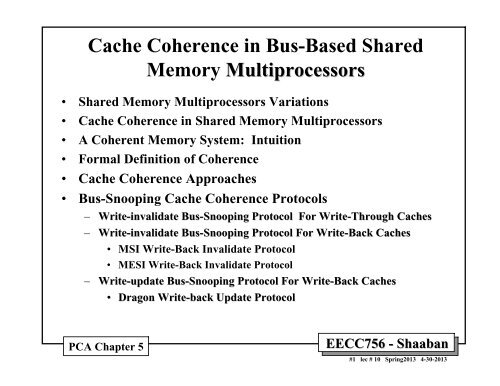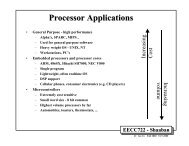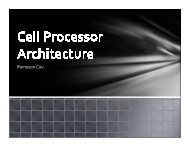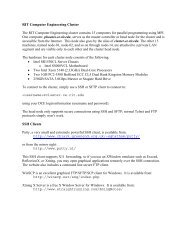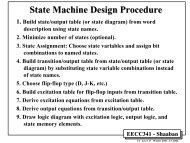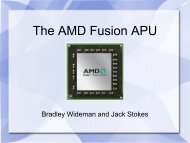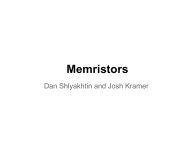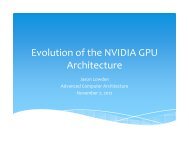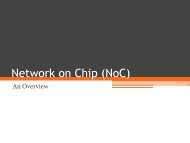EECC756 - Shaaban
EECC756 - Shaaban
EECC756 - Shaaban
You also want an ePaper? Increase the reach of your titles
YUMPU automatically turns print PDFs into web optimized ePapers that Google loves.
Cache Coherence in Bus-Based SharedMemory Multiprocessors• Shared Memory Multiprocessors Variations• Cache Coherence in Shared Memory Multiprocessors• A Coherent Memory System: Intuition• Formal Definition of Coherence• Cache Coherence Approaches• Bus-Snooping Cache Coherence Protocols– Write-invalidate invalidate Bus-Snooping Protocol For Write-Through Caches– Write-invalidate invalidate Bus-Snooping Protocol For Write-Back Caches• MSI Write-Back Invalidate Protocol• MESI Write-Back Invalidate Protocol– Write-update Bus-Snooping Protocol For Write-Back Caches• Dragon Write-back Update ProtocolPCA Chapter 5<strong>EECC756</strong> - <strong>Shaaban</strong>#1 lec # 10 Spring2013 4-30-2013
Shared Memory MultiprocessorsCache DataInconsistency/CoherenceProblem• Direct support in hardware of shared address space (SAS)parallel programming model: address translation and protectionin hardware (hardware SAS).• Any processor can directly reference any memory location– Communication occurs implicitly as result of loads and stores• Normal uniprocessor mechanisms used to access data (loads andstores) + synchronization– Key is extension of memory hierarchy to support multipleprocessors. Extended memory hierarchy• Memory may be physically distributed among processors• Caches in the extended memory hierarchy may have multipleinconsistent copies of the same data leading to data inconsistencyor cache coherence problem that have to addressed by hardwarearchitecture.<strong>EECC756</strong> - <strong>Shaaban</strong>#2 lec # 10 Spring2013 4-30-2013
Shared Memory Multiprocessors:Support of Programming ModelsMessage passingProgramming modelsShared address spaceCompilationor libraryMultiprogrammingCommunication abstractionUser/system boundaryOperating systems supportCommunication hardwarePhysical communication medium• Address translation and protection in hardware(hardware SAS).• Message passing using shared memory buffers:Hardware/software boundary• Can offer very high performance since no OS involvementnecessary.• The focus here is on supporting a consistent or coherentshared address space.<strong>EECC756</strong> - <strong>Shaaban</strong>#3 lec # 10 Spring2013 4-30-2013
Shared Memory Multiprocessors Variations• Uniform Memory Access (UMA) Multiprocessors :– All processors have equal access to all memory addresses.– Can be further divided into three types:• Bus-based shared memory multiprocessors– Symmetric Memory Multiprocessors (SMPs).• Shared cache multiprocessors• Dancehall multiprocessorse.g. CMPs (multi-core processors)• Non-uniform Memory Access (NUMA) or distributedmemory Multiprocessors :– Shared memory is physically distributed locally amongprocessors (nodes). Access to remote memory is higher.– Most popular design to build scalable systems (MPPs).– Cache coherence achieved by directory-based methods.<strong>EECC756</strong> - <strong>Shaaban</strong>#4 lec # 10 Spring2013 4-30-2013
Shared Memory Multiprocessors VariationsP 1SwitchP nSymmetric Memory Multiprocessors(SMPs)P nP 1$ $UMAe.g CMPs(interleaved) (Interleaved)Second-level First-level $ $Bus or point-to-pointinterconnects BusUMA(Interleaved)Main memoryMemI/O devices(a) Shared cache(b) Bus-based shared memoryOr SMP nodesP nP 1Scalable DistributedShared MemoryP nP 1$UMAInterconnection network$Mem$Mem$Mem(c) DancehallMemScalable networkp-to-p or MINInterconnection network(d) Distributed-memoryNUMA<strong>EECC756</strong> - <strong>Shaaban</strong>#5 lec # 10 Spring2013 4-30-2013
Uniform Memory Access (UMA) Multiprocessors• Bus-basedMultiprocessors: (SMPs)– A number of processors (commonly 2-4) 2in a single node share physical memory viasystem bus or point-toto-point interconnects (e.g. AMD64 via. HyperTransport)– Symmetric access to all of main memory from any processor.• Commonly called: Symmetric Memory Multiprocessors (SMPs).– Building blocks for larger parallel systems (MPPs, clusters)– Also attractive for high throughput servers– Bus-snooping mechanisms used to address the cache coherency problem.• Shared cache Multiprocessor Systems:– Low-latency sharing and prefetching across processors.– Sharing of working sets.– No cache coherence problem (and hence no false sharing either).– But high bandwidth needs and negative interference (e.g. conflicts).– Hit and miss latency increased due to intervening switch and cache size.– Used in mid 80s to connect a few of processors on a board (Encore, Sequent).– Used currently in chip multiprocessors (CMPs): 2-4 processors on a single chip.e.g IBM Power 4, 5: two processor cores on a chip (shared L2).• Dancehall:– No local memory associated with a node.– Not a popular design: All memory is uniformly costly to access over the network for allprocessors.<strong>EECC756</strong> - <strong>Shaaban</strong>#6 lec # 10 Spring2013 4-30-2013
Uniform Memory Access Example:Intel Pentium Pro QuadCPUInterruptcontrollerBus interface256-KBL 2 $P-PromoduleP-PromoduleCirca 1997P-PromoduleSharedFSBP-Pro bus (64-bit data, 36-bit addr ess, 66 MHz)PCIbridgePCIbridgeMemorycontrollerPCII/OcardsPCI busPCI busMIU1-, 2-, or 4-wayinterleavedDRAMBus-Based Symmetric Memory Processors (SMPs).A single Front Side Bus (FSB) is shared among processorsThis severely limits scalability to only 2-4 processors• All coherence and multiprocessingglue in processor module• Highly integrated, targeted at highvolumeRepeated here from lecture 1<strong>EECC756</strong> - <strong>Shaaban</strong>#7 lec # 10 Spring2013 4-30-2013
Non-Uniform Memory Access (NUMA)Example: AMD 8-way 8Opteron Server NodeCirca 2003Dedicated point-to-point interconnects (Coherent HyperTransport links) used toconnect processors alleviating the traditional limitations of FSB-based SMPsystems (yet still providing the cache coherency support needed)Each processor has two integrated DDR memory channel controllers:memory bandwidth scales up with number of processors.NUMA architecture since a processor can access its own memory at a lower latencythan access to remote memory directly connected to other processors in the system.Total 16 processor cores whendual core Opteron processors usedRepeated here from lecture 1<strong>EECC756</strong> - <strong>Shaaban</strong>#8 lec # 10 Spring2013 4-30-2013
Chip Multiprocessor (Shared-Cache) Example:CMPIBM Power 4Two Processor cores on a chipshare level 2 cache<strong>EECC756</strong> - <strong>Shaaban</strong>#9 lec # 10 Spring2013 4-30-2013
Complexities of MIMD Shared Memory Access• Relative order (interleaving) of instructions in differentstreams in not fixed.– With no synchronization among instructions streams,a large number of instruction interleavings is possible.• If instructions are reordered in a stream then an evenlarger of number of instruction interleavings islargerpossible.i.e Effect of access not visible to memory,all processors in the same order• If memory accesses are not atomic with multiple copiesof the same data coexisting (cache-based systems) thendifferent processors observe different interleavingsduring the same execution. The total number of possibleobserved execution orders becomes even larger.i.e orders<strong>EECC756</strong> - <strong>Shaaban</strong>#10 lec # 10 Spring2013 4-30-2013
Cache Coherence in Shared MemoryMultiprocessors• Caches play a key role in all shared memory multiprocessor systemvariations:– Reduce average data access time (AMAT).– Reduce bandwidth demands placed on shared interconnect.• Replication in cache reduces artifactual communication.• Cache coherence or inconsistency problem.– Private processor caches create a problem:• Copies of a variable can be present in multiple caches.• A write by one processor may not become visible to others:– Processors accessing stale (old) value in their private caches.• Also caused by:– Process migration.– I/O activity.– Software and/or hardware actions needed to ensure:• 1- Write visibility to all processors 2- in correct orderthus maintaining cache coherence.• i.e. Processors must see the most updated value<strong>EECC756</strong> - <strong>Shaaban</strong>#11 lec # 10 Spring2013 4-30-2013
Cache Coherence Problem ExampleFromP 1$P 2 main memory P 3u = ?u = ?4 $ 5$u:5u:5u = 73Write BackCaches Assumed1u:5Memory2I/O devices1 P1 reads u=5 from memory2 P3 reads u=5 from memory3 P3 writes u=7 to local P3 cache4 P1 reads old u=5 from local P1 cache5 P2 reads old u=5 from memory– Processors see different values for u after event 3.– With write back caches, a value updated in cache may not havebeen written back to memory:• Processes even accessing main memory may see very stale value.– Unacceptable: leads to incorrect program execution.PCA page 274Write by P3not visible to P1, P2<strong>EECC756</strong> - <strong>Shaaban</strong>#12 lec # 10 Spring2013 4-30-2013Time
A Coherent Memory System: IntuitionReading a memory location should return the latest valuewritten (by any process).• Easy to achieve in uniprocessors:– Except for DMA-based I/O: Coherence between DMA I/O devices andprocessors.– Infrequent so software solutions work:• Uncacheable memory regions, uncacheable operations, flush pages,pass I/O data through caches.• The same should hold when processes run on different processors:– e.g. Results should be the same as if the processes were interleaved (orrunning) on a uniprocessor.• Coherence problem much more critical in multiprocessors:– Pervasive.– Performance-critical.– Must be treated as a basic hardware design issue.PCA page 275<strong>EECC756</strong> - <strong>Shaaban</strong>#13 lec # 10 Spring2013 4-30-2013
Basic DefinitionsExtend definitions in uniprocessors to multiprocessors:• Memory operation: a single read (load), write (store) or read-modifywriteaccess to a memory location.– Assumed to execute atomically: 1- (visible) with respect to (w.r.t) eachother and 2- in the same order.• Issue: A memory operation issues when it leaves processor’s internalenvironment and is presented to memory system (cache, buffer …).• Perform: operation appears to have taken place, as far as processorcan tell from other memory operations it issues.– A write performs w.r.t. the processor when a subsequent read by theprocessor returns the value of that write or a later write (no RAW,WAW).– A read perform w.r.t the processor when subsequent writes issued bythe processor cannot affect the value returned by the read (no WAR).• In multiprocessors, stay same but replace “the” by “a” processor– Also, complete: perform with respect to all processors.– Still need to make sense of order in operations from different processes.PCA page 276<strong>EECC756</strong> - <strong>Shaaban</strong>#14 lec # 10 Spring2013 4-30-2013
Shared Memory Access Consistency• A load by processor P i is performed with respect toprocessor P k at a point in time when the issuing of asubsequent store to the same location by P k cannot affectthe value returned by the load (no WAW, WAR).• A store by P i is considered performed with respect to P kat one time when a subsequent load from the sameaddress by P k returns the value by this store (no RAW).• A load is globally performed (i.e. complete) if it isperformed with respect to all processors and if the storethat is the source of the returned value has beenperformed with respect to all processors.<strong>EECC756</strong> - <strong>Shaaban</strong>#15 lec # 10 Spring2013 4-30-2013
Formal Definition of Coherence• Results of a program: values returned by its read (load) operations• A memory system is coherent if the results of any execution of aprogram are such that for each location, it is possible to constructa hypothetical serial order of all operations to the location that isconsistent with the results of the execution and in which:1. operations issued by any particular process occur in the orderissued by that process, and2. the value returned by a read is the value written by the latest writeto that location in the serial order• Two necessary conditions:– Write propagation: value written must become visible to others– Write serialization: writes to location seen in same order by all• if one processor sees w1 after w2, another processor should notsee w2 before w1• No need for analogous read serialization since reads not visible toothers.PCA page 276-277i.e processors<strong>EECC756</strong> - <strong>Shaaban</strong>#16 lec # 10 Spring2013 4-30-2013
Write Atomicity• Write Atomicity: Position in total order at which a writeappears to perform should be the same for all processes:Time– Nothing a process does after it has seen the new value producedby a write W should be visible to other processes until they toohave seen W.– In effect, extends write serialization to writes from multipleprocesses.P 1 P 2 P 3A=1;while (A==0);B=1;while (B==0);print A;•Problem if P 2 leaves loop, writes B, and P 3 sees new B but oldA (from its cache, i.e cache coherence problem).Old A?PCA page 289<strong>EECC756</strong> - <strong>Shaaban</strong>#17 lec # 10 Spring2013 4-30-2013
Cache Coherence Approaches• Bus-Snooping Protocols: Used in bus-based systems where allprocessors observe memory transactions and take proper action toinvalidate or update local cache content if needed.• Directory Schemes: Used in scalable cache-coherent distributedmemorymultiprocessor systems where cache directories are used tokeep a record on where copies of cache blocks reside.• Shared Caches:– No private caches.Not Scalable– This limits system scalability (limited to chip multiprocessors, CMPs).• Non-cacheable Data:– Not to cache shared writable data:• Locks, process queues.• Data structures protected by critical sections.– Only instructions or private data is cacheable.– Data is tagged by the compiler.• Cache Flushing:– Flush cache whenever a synchronization primitive is executed.– Slow unless special hardware is used.ScalableNot Scalable<strong>EECC756</strong> - <strong>Shaaban</strong>#18 lec # 10 Spring2013 4-30-2013
Cache Coherence Using A Bus• Built on top of two fundamentals of uniprocessor systems:i.e .SMPs1 Bus transactions.2 State transition diagram of cache blocks.• Uniprocessor bus transaction:– Three phases: arbitration, command/address, data transfer.– All devices observe addresses, one is responsible for transaction• Uniprocessor cache block states:– Effectively, every block is a finite state machine.– Write-through, write no-allocate has two states:valid, invalid.– Write-back caches have one more state: Modified (“dirty”).• Multiprocessors extend both these two fundamentalssomewhat to implement cache coherence using a bus.PCA page 274Three States: Valid (V), Invalid (I), Modified (M)<strong>EECC756</strong> - <strong>Shaaban</strong>#19 lec # 10 Spring2013 4-30-2013
Basic Idea:Bus-Snooping Cache CoherenceProtocols• Transactions on bus are visible to all processors.• Processors or bus-watching (bus snoop) mechanisms can snoop(monitor) the bus and take action on relevant events (e.g. changestate) to ensure data consistency among private caches and sharedmemory.Basic Protocol Types:1• Write-invalidate:Invalidate all remote copies of when a local cache block isupdated.• Write-update:2When a local cache block is updated, the new data block is broadcast toall caches containing a copy of the block updating them.<strong>EECC756</strong> - <strong>Shaaban</strong>#20 lec # 10 Spring2013 4-30-2013
Write-invalidate invalidate & Write-update CoherenceProtocols for Write-through through Caches• See handout• Figure 7.14 in Advanced ComputerArchitecture: Parallelism, Scalability,Programmability, Kai Hwang.<strong>EECC756</strong> - <strong>Shaaban</strong>#21 lec # 10 Spring2013 4-30-2013
Implementing Bus-Snooping Protocols• Cache controller now receives inputs from both sides:1 Requests from local processor2 Bus requests/responses from bus snooping mechanism .• In either case, takes zero or more actions:– Possibly: Updates state, responds with data, generates newbus transactions. i.e invalidate or update other shared copies• Protocol is a distributed algorithm: Cooperating statemachines.– Set of states, state transition diagram, actions.• Granularity of coherence is typically a cache blockChange Block StateBus action– Like that of allocation in cache and transfer to/from cache.– False sharing of a cache block may generate unnecessarycoherence protocol actions over the bus.Cache block falsely sharedPCA page 280between P0 and P1 X YP0P1<strong>EECC756</strong> - <strong>Shaaban</strong>#22 lec # 10 Spring2013 4-30-2013
Coherence with Write-through through CachesP 1$Bus snoopPossible Action: Invalidate or updatecache block in P1 if sharedP n$SnoopInvalidate or update shared copiesSnoopMemWrite throughto memoryI/O devicesCache-memorytransaction(Write)• Key extensions to uniprocessor: snooping, invalidating/updatingcaches:• Invalidation- versus update-based protocols.• Write propagation: even in invalidation case, later reads will seenew value:• Invalidation causes miss on later access, and memory update viawrite-through.<strong>EECC756</strong> - <strong>Shaaban</strong>#23 lec # 10 Spring2013 4-30-2013
TwoStates:IInvalidationActionWrite-invalidate invalidate Bus-Snooping Protocol:For Write-Through CachesThe state of a cache block copy of local processor i cantake one of two states (j represents a remote processor):Valid State:V• All processors can read (R(i), R(j)) safely.• Local processor i can also write W(i)• In this state after a successful read R(i) or write W(i)Invalid State:not in cache or,• Block being invalidated.• Block being replaced Z(i) or Z(j)• When a remote processor writes W(j) to its cache copy, allother cache copies become invalidated. V I– Bus write cycles are higher than bus read cycles due torequest invalidations to remote caches.Assuming write allocatei = Local Processorj = Other (remote) processor<strong>EECC756</strong> - <strong>Shaaban</strong>#24 lec # 10 Spring2013 4-30-2013
Write-invalidate invalidate Bus-Snooping ProtocolR(j)Z(j)Z(i)W(j)For Write-Through CachesState Transition DiagramInvalidIR(i), W(i)W(j), Z(i)ValidVW(i) = Write to block by processor iW(j) = Write to block copy in cache j by processor j ≠ iR(i) = Read block by processor i.R(j) = Read block copy in cache j by processor j ≠ iZ(i) = Replace block in cache .Z(j) = Replace block copy in cache j ≠ ii local processor j other processorLocal writeAssuming writeallocate usedFor a cache blockin local processor iR(i)W(i)R(j)Z(j)Write by other processor j, invalidate<strong>EECC756</strong> - <strong>Shaaban</strong>#25 lec # 10 Spring2013 4-30-2013
PrRd/—A read bythis processorA read bythis processorPrRd/BusRdA write by otherprocessor to blocki.e W(j)PrWr/BusWrWrite-invalidate invalidate Bus-Snooping Protocoli.e R(i)VIPrWr/BusWrA write bythis processori.e W(j)BusWr/—Snooper sensesa write by other processorto same block -> invalidateFor Write-Through CachesAlternate State Transition DiagramProcessor-initiated transactionsBus-snooper-initiated transactionsV = ValidI = InvalidA/B means if A is observed B is generated.Processor Side Requests:read (PrRd)write (PrWr)Bus Side or snooper/cache controller Actions:bus read (BusRd)bus write (BusWr)– Two states per block in each cache, as in uniprocessor.• state of a block can be seen as p-vector (for all p processors). p bits– Hardware state bits associated with only blocks that are in the cache.• other blocks can be seen as being in invalid (not-present) state in that cache– Write will invalidate all other caches (no local change of state).• can have multiple simultaneous readers of block,but write invalidates them.PCA page 281i.e W(i)<strong>EECC756</strong> - <strong>Shaaban</strong>#26 lec # 10 Spring2013 4-30-2013
Problems With Write-Through• High bandwidth requirements:– Every write from every processor goes to shared bus and memory.– Consider 200MHz, 1 CPI processor, and 15% of the instructionsare 8-byte stores.– Each processor generates 30M stores or 240MB data per second.– 1GB/s bus can support only about 4 processors without saturating.– Write-through especially is unpopular for SMPs.• Write-back caches absorb most writes as cache hits:– Write hits don’t go on bus. Visible to all– But now how do we ensure write propagation and serialization?• Requires more sophisticated coherence protocols.In correct orderi.e write atomicityPCA page 283<strong>EECC756</strong> - <strong>Shaaban</strong>#27 lec # 10 Spring2013 4-30-2013
ThreeStates:Basic Write-invalidate invalidate Bus-Snooping Protocol:For Write-Back Caches• Corresponds to ownership protocol. i.e which processor owns the block• Valid state in write-through protocol is divided into two states (3 states total):RW (read-write): (this processor i owns block) or Modified M• The only cache copy existing in the system; owned by the local processor.• Read (R(i)) and (W(i)) can be safely performed in this state.RO (read-only): or Shared S• Multiple cache block copies exist in the system; owned by memory.• Reads ((R(i)), ((R(j)) can safely be performed in this state.INV (invalid): I• Entered when : Not in cache or,– A remote processor writes (W(j) to its cache copy.– A local processor replaces (Z(i) its own copy.• A cache block is uniquely owned after a local write W(i)• Before a block is modified, ownership for exclusive access is obtained by a readonlybus transaction broadcast to all caches and memory.• If a modified remote block copy exists, memory is updated (forced write back),local copy is invalidated and ownership transferred to requesting cache.i = Local Processorj = Other (remote) processorFor a cache block in local processor i<strong>EECC756</strong> - <strong>Shaaban</strong>#28 lec # 10 Spring2013 4-30-2013
Write-invalidate Bus-Snooping ProtocolFor Write-Back CachesState Transition DiagramFor a cache block in local processor iR(i)W(i)Z(j)RW(Processor iowns block)i local processorj other processorW(i)W(j)Z(i)R(j)W(i)INVForce write backR(i)ROOwned bymemoryW(j), Z(i)RW: Read-WriteRO: Read OnlyINV: Invalidated ornot in cacheR(i)R(j)Z(j)Other processor writesinvalidateW(i) = Write to block by processor iW(j) = Write to block copy in cache j by processor j ≠ iR(i) = Read block by processor i.R(j) = Read block copy in cache j by processor j ≠ iZ(i) = Replace block in cache .Z(j) = Replace block copy in cache j ≠ iR(j), Z(j), W(j), Z(i)<strong>EECC756</strong> - <strong>Shaaban</strong>#29 lec # 10 Spring2013 4-30-2013
Basic MSI Write-Back Invalidate ProtocolThreeStates:PCA page 293• States:– Invalid (I).– Shared (S): Shared unmodified copies exist.– Dirty or Modified (M): One only valid, other copiesmust be invalidated.• Processor Events:– PrRd (read).– PrWr (write).MSI is similar to previous protocol just different representation(i.e still corresponds to ownership protocol)MSIModified Shared Invalid• Bus Transactions:– BusRd: Asks for copy with no intent to modify.– BusRdX: Asks for copy with intent to modify.– BusWB: Updates memory.e.g write back to memory• Actions:– Update state, perform bus transaction, flush valueonto bus (forced write back).<strong>EECC756</strong> - <strong>Shaaban</strong>#30 lec # 10 Spring2013 4-30-2013
ThreeStates:Basic MSI Write-Back Invalidate ProtocolState Transition DiagramM = Dirty or Modified, main memoryis not up-to-date, owned by localprocessorS = Shared, main memory is up-to-dateowned by main memoryI = InvalidProcessor Side Requests:Block ownedread (PrRd)by main memorywrite (PrWr)Bus Side or snooper/cache controller Actions:Bus Read (BusRd)Bus Read Exclusive (BusRdX)bus write back (BusWB) FlushPrWr/BusRdXPrRd/BusRdPrWr/BusRdXPrRd/—MSPrRd/—BusRd/—IPrWr/—BusRd/FlushBlock ownedby local processorBusRdX/FlushBusRdX/—ForcedWrite BackBusWBInvalidate– Replacement changes state of two blocks: Outgoing and incoming.PCA page 295Processor InitiatedBus-Snooper InitiatedStill an ownership protocol<strong>EECC756</strong> - <strong>Shaaban</strong>#31 lec # 10 Spring2013 4-30-2013
Modified Exclusive Shared InvalidSolution:MESI (4-state) Invalidation Protocol• Problem with MSI protocol:– Reading and modifying data is 2 bus transactions, even if not sharing:• e.g. even in sequential program.• BusRd ( I-> S ) followed by BusRdX ( S -> M ).• Add exclusive state (E): Write locally without a bus transaction, but notmodified:– Main memory is up to date, so cache is not necessarily the owner.New “shared” bussignal needed– Four States:• Invalid (I).• Exclusive or exclusive-clean (E): Only this cache has a copy, butnot modified; main memory has same copy.• Shared (S): Two or more caches may have copies.• Modified (M): Dirty.– I -> E on PrRd if no one else has copy. i.e. shared signal, S = 0• Needs “shared” signal S on bus: wired-or line asserted in responseto BusRd.S = 0 Not SharedS = 1 Sharedi.e no other cachehas a copy<strong>EECC756</strong> - <strong>Shaaban</strong>#32 lec # 10 Spring2013 4-30-2013
MESI State Transition DiagramFour States:M = Modified or DirtyE = ExclusiveS = SharedI = InvalidPrWr/BusRdXPrWr/BusRdXPrWr/—MEPrRd/—PrRdPrWr/—BusRd/FlushBusRd/FlushBusRdX/FlushBusRdX/FlushInvalidate / ForcedWrite BackSBusRdX/Flush′S = shared signal= 0 not shared= 1 sharedNot SharedPrRd/BusRd (S)PrRd/—BusRd/Flush′PrRd/BusRd(S)IShared– BusRd(S) Means shared line asserted on BusRd transaction.– Flush: If cache-to-cache sharing, only one cache flushes data.<strong>EECC756</strong> - <strong>Shaaban</strong>#33 lec # 10 Spring2013 4-30-2013
Invalidate Versus Update• Basic question of program behavior:– Is a block written by one processor read by others before it isrewritten (i.e. written-back)?• Invalidation:– Yes => Readers will take a miss.– No => Multiple writes without additional traffic.• Clears out copies that won’t be used again.• Update:– Yes => Readers will not miss if they had a copy previously.• Single bus transaction to update all copies.– No => Multiple useless updates, even to dead copies.• Need to look at program behavior and hardware complexity.• In general, invalidation protocols are much more popular.– Some systems provide both, or even hybrid protocols.<strong>EECC756</strong> - <strong>Shaaban</strong>#34 lec # 10 Spring2013 4-30-2013
Update-Based Bus-Snooping Protocols• A write operation updates values in other caches.– New, update bus transaction.• Advantages:– Other processors don’t miss on next access: reduced latency• In invalidation protocols, they would miss and cause moretransactions.– Single bus transaction to update several caches can savebandwidth.• Also, only the word written is transferred, not whole block• Disadvantages:– Multiple writes by same processor cause multiple updatetransactions.• In invalidation, first write gets exclusive ownership, others local• Detailed tradeoffs more complex.Depending on program behavior/hardware complexity<strong>EECC756</strong> - <strong>Shaaban</strong>#35 lec # 10 Spring2013 4-30-2013
Dragon Write-back Update Protocol• 4 states:– Exclusive-clean or exclusive (E): I and memory have this block.– Shared clean (Sc): I, others, and maybe memory, but I’m not owner.– Shared modified (Sm): I and others but not memory, and I’m theowner.• Sm and Sc can coexist in different caches, with only one Sm.– Modified or dirty (D): I have this block and no one else, stale memory.• No explicit invalid state (implied).– If in cache, cannot be invalid.– If not present in cache, can view as being in not-present or invalid state.• New processor events: PrRdMiss, PrWrMiss.– Introduced to specify actions when block not present in cache.• New bus transaction: BusUpd.– Broadcasts single word written on bus; updates other relevant caches.PCA page 301Fifth (Invalid) State ImpliedThat was modified in owner’s cacheAlso requires “shared” signal Son bus (similar to MESI)<strong>EECC756</strong> - <strong>Shaaban</strong>#36 lec # 10 Spring2013 4-30-2013
Dragon State Transition DiagramS = SharedS = Not SharedPrRd/—S = shared signal= 0 not shared= 1 sharedPrRd/—BusUpd/UpdateIPrRdMiss/BusRd(S)EBusRd/—ScIPrRdMiss/BusRd(S)Four States:E = ExclusiveSc = Shared cleanSm = Shared modifiedM = ModifiedSharedPrWrMiss/(BusRd(S); BusUpd)Not sharedBusUpd/UpdateUpdateothersSmPrWr/—SupplydataBusRd/FlushPrWr/BusUpd(S)SharedPrWr/BusUpd(S)Update othersMSharedPrWr/BusUpd(S)Not sharedPrWrMiss/BusRd(S)This Processoris ownerPrRd/—PrWr/BusUpd(S)BusRd/FlushSupply dataSharedBusUpd = Broadcast word written on bus to update other cachesNot sharedPrRd/—PrWr/—<strong>EECC756</strong> - <strong>Shaaban</strong>#37 lec # 10 Spring2013 4-30-2013


